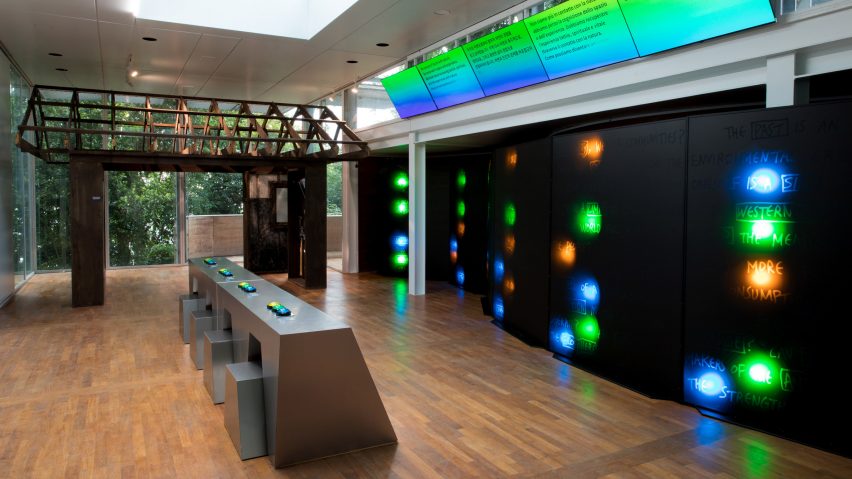A quiz show-style game that focuses on social, political and economic issues surrounding climate change is on show at the Korean Pavilion at Venice Architecture Biennale, which is revealed exclusively on Dezeen.
Korea's exhibition is titled 2086: Together How? and was curated by artistic directors Soik Jung and Kyong Park. The exhibition questions how people might work together and collaborate to endure current and future environmental crises up until the year 2086.
In a report conducted by the UN, 2086 was projected as the year in which the global population is expected to peak at an estimated 10.4 billion people. It is projected to remain at that level until 2100, before starting to decline by around 10 million a year.
"The concept of '2086: Together How?' is to interrogate our Faustian ideology of progress and how we have sought unlimited material pleasure through industrialization, westernization, and liberalism, and our reparations of the past colonial exploitations is the first step in our reconciliation with nature," Jung and Park told Dezeen.
A main component of the exhibition is a quiz show-style game titled "The Game of Together How" that invites visitors to answer multiple-choice questions on issues surrounding climate change, which are presented to players via on-screen fictional scenarios.
"The idea behind 'The Game of Together How' is to put everyday people into a reality TV quiz show-like situation where they can have a fictional but direct contact with 'climate endgame," said Jung and Park.
"It also connects them to the future scenarios and choices they may have to make to survive in 17 questions posed, and at the same time connecting them to their past activities and cultures that produced the environment crisis," said the curators.
"By keeping scores of their decisions, we could fictionally predict their chances of survival in seven different ecological categories from 2023 to 2086, during the period of exhibition."
Alongside the game, a trio of collaborations led by architecture studios and community activists focus on the potential future outcomes of South Korean cities as a result of rising populations.
Seoul-based studio Society of Architecture and local activist group Udangtangtang used Gunsan, a former South Korean fishing city turned US air base with a declining population, as a case study for their contribution to the exhibition.
The studios recreated a partially demolished home to exhibit designs that respond to the city's declining population. They also explored ways in which Gunsan's nomadic people could reintroduce nature and native wildlife into abandoned and derelict areas through guerrilla-style events.
"By teaming up architects with local community leaders and activists, we have generated various future possibilities for decentralization, localism and collective projects and actions," said Jung and Park.
"Altogether, we are looking for the revival of local legacy, independent economy and cultures, self-sufficient cooperative capitalism, and a more balanced life with nature."
Architecture studio Urban Terrains Lab collaborated with activist group Space Beam to create an installation titled Ruin as Future, Future as Ruin.
The installation focuses on the historic village of Baedari in East Incheon, South Korea, and the work undertaken by its community top stop the construction of a highway in the area.
"Having stopped the completion of a major highway that destroyed much of its community, Baedari's resistance raises urgent questions about its future between post-Anthropocene and neo-Holocene life," said the pavilion's notes.
The pavilion also features Migrating Futures, a project by New York-based studio NHDM focused on foreign migrants in South Korea, and Korean artist Wolsik Kim's A Community of Difference, which envisions a future in which borders no longer function as physical boundaries.
According to the curators, rather than respond with solutions and answers, the pavilion aims to pose questions surrounding issues of globalisation and "capitalism of desires."
"We should free ourselves from the 'capitalism of desires' and return to 'capitalism of necessity,' and begin our reparation with nature through our reparation of colonial history," they said.
"Through our exhibition, we hope that people would begin to think about why are we so 'isolated' when we are supposed to be so 'connected' through the globalization of information, finance, and even culture?"
"Why are we so insecure about our future when so many of us are living at unprecedented levels of wealth, consumption, and freedom?" they added. "Why then is the idea of progress taking us closer to extinction than to our perfection that it promised?"
"Then they could realize that not only will the environmental crisis force us to come up with a better ecocultural paradigm, more importantly, it will be our best and last chance to become a better humanity."
Other pavilions and installations recently unveiled on Dezeen include the Swiss Pavilion, which removed a wall and numerous gates that separates it from the neighbouring Venezuelan pavilion.
The photography is by Agne Raceviciute.
Dezeen is live reporting from the Venice Architecture Biennale, which takes place from 20 May to 26 November 2023. See Dezeen Events Guide for all the latest information you need to know to attend the event, as well as a list of other architecture and design events taking place around the world.

